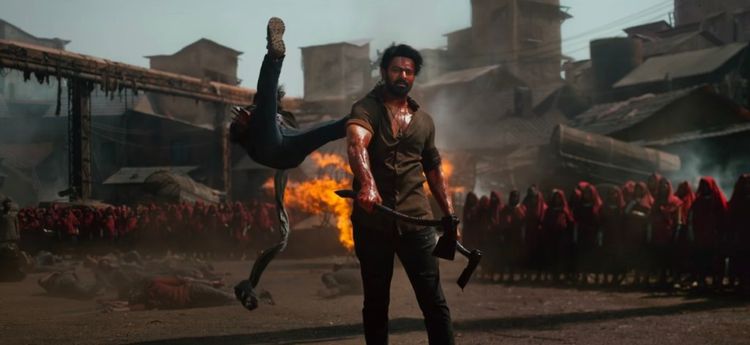'Salaar: Part 1 – Ceasefire' Review: Indian Epic of Violent Delights

Leaning full-tilt into its duology structure, Tollywood action drama “Salaar: Part 1 – Ceasefire” has a winding, often confounding narrative aimed at building up a sequel, but its maximalist action tableaus always yield dividends. After his previous two-parter “K.G.F.” smashed Indian box-office records for Kannada-language films, director Prashanth Neel employs the talents of ultra-charismatic superstar Prabhas (the star of S.S. Rajamouli’s “Baahubali” series) as the silent, stewing protagonist Deva, in a grimy guns-and-gangsters melodrama.
At first, the story plays its cards close to its chest before transforming wildly and suddenly into a mythological epic about secret societies and millennia-old blood feuds. At 174 minutes long, with nested flashbacks overflowing with exposition, the movie has lengthy stretches that can feel like a chore. However, each extraneous segment eventually converges in some of the most exhilarating and cathartic on-screen violence Indian cinema has to offer.
Opening with a series of flashbacks, “Salaar: Part 1” swiftly establishes a teenage Deva as both loyal and fearsome. In order to protect the honor of his best friend Vardha — the son of the powerful Mannar family, though who they are is initially vague — he defeats an adult wrestler in innovative but self-destructive fashion, leaving him with a distinctive scar up his arm and neck. Before long, Vardha returns the favor by helping Deva and his mother (Easwari Rao) escape a threat left similarly nonspecific, and as they enter self-imposed exile, Vardha brands Deva his “salaar”: a one-man army called upon in a time of need — a position he claims dates back to Persian kings.
This prologue swiftly gives way to a contemporary, mile-a-minute tale of vengeance and surveillance, in which new characters are introduced faster than the mind can comprehend. Various armed factions are on the hunt for a young woman, Shruti (Aadhya Krishnakanth), the daughter of a prominent industrialist who has in some way wronged a powerful Indian politician and her catatonic sister. The only people capable of protecting Shruti from a nationwide manhunt are a now-adult Deva and his mother, who are hiding out as a day laborer and a school teacher in the eastern state of Assam.
Presenting snippets of memories in which Deva’s brutality is impressionistically implied, Neel creates immense anticipation for the action to come. The screen jitters each time righteous bloodshed crosses Deva’s mind. When the first major action scene finally arrives, “Salaar” indulges in gratuitous hero worship, as slo-mo shots revere not only Prabhas’ stature, build and poise, but his reluctance to engage in the ritual of cinematic violence. Blood and limbs fly in all directions, as Neel and DP Bhuvan Gowda turn the contrast up on their desaturated images, making each environmental element — dust, rain, even drops of blood — even more noticeable.
More fights and chases ensue, building to an armed collision that brings a whole new meaning to “automatic weaponry.” No character’s motivation is ever quite clear except Deva’s (the righteous, godlike protection of innocents), but the action is so absorbing and overwhelming that making sense of the story becomes a secondary concern. However, when the pieces finally do fall into place, this strange narrative withholding starts to make sense, even if the answers are completely unexpected.
Most Indian blockbusters are structured around an intermission, but “Salaar: Part 1” feels best divided by a turn a little over hour in, when it ceases to be a straightforward story about a man on a righteous mission and becomes instead an entire season of “Game of Thrones.” After its first-act denouement, the rest of the story unfolds entirely in flashback as narrated by a character in the present, who finally reveals the reasons for the strange secrecy behind the plot. It involves not only a Wakanda-esque hidden society on the border of India and Pakistan, but tribal rivalries dating back centuries.
Eventually, Deva’s childhood best friend Vardha (Prithviraj Sukumaran) enters the fray, revealing that he had called upon Deva for his help, several years ago. That call, and its consequences during a political power grab spanning multiple continents consumes what was initially presented as the movie’s plot, albeit for good reason. Neel, who wrote the screenplay, is intent to a fault on creating a sprawling cinematic lore on par with “The Lord of the Rings” or Hindu epics like the “Mahabharat,” even if it means sacrificing dramatic coherence for lengthy stretches.
Despite these dumbfounding complications, he continues to build Deva’s violent outbursts as reluctant rituals of violence, instilling in the audience a rabid desire to see Prabhas let loose on villainous goons. He even turns a recurring shot of Deva’s shadow, arms crossed in inaction, into a thrilling motif, as though the mere act of uncrossing his arms were the beginning of a steady demolition, en route to poses associated with demonic figures of Hindu scripture.
On one hand, this bizarre, inside-out structure renders the movie’s first act a mere setup for the movie’s sequel (“Salaar: Part 2 – Shouryaanga Parvam,” currently in development). On the other hand, Neel ensures that each action scene in “Part 1” builds on its predecessor regardless of chronology. The film’s climax may unfold five years before the kidnapping saga in its present, but it makes for a fiery, cathartic crescendo rife with visual escalation and dramatic possibility. For a film that runs nearly 3 hours, its action scenes may feel few and far between, but each and every one of them is worth the wait.



























































